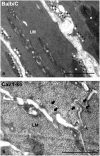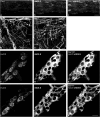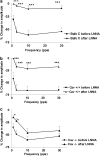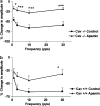Caveolin-1 gene knockout impairs nitrergic function in mouse small intestine
- PMID: 15937515
- PMCID: PMC1576236
- DOI: 10.1038/sj.bjp.0706289
Caveolin-1 gene knockout impairs nitrergic function in mouse small intestine
Abstract
Caveolin-1 is a plasma membrane-associated protein that is responsible for caveolae formation. It plays an important role in the regulation of the function of different signaling molecules, among which are the different isoforms of nitric oxide synthase (NOS). Nitric oxide (NO) is known to be an important inhibitory mediator in the mouse gut. Caveolin-1 knockout mice (Cav1(-/-)) were used to examine the effect of caveolin-1 absence on the NO function in the mouse small intestine (ileum and jejunum) compared to their genetic controls and BALB/c controls. Immunohistochemical staining showed loss of caveolin-1 and NOS in the jejunal smooth muscles and myenteric plexus interstitial cells of Cajal (ICC) of Cav1(-/-) mice; however, nNOS immunoreactive nerves were still present in myenteric ganglia. Under nonadrenergic noncholinergic (NANC) conditions, small intestinal tissues from Cav1(-/-) mice relaxed to electrical field stimulation (EFS), as did tissues from control mice. Relaxation of tissues from control mice was markedly reduced by N-omega-nitro-L-arginine (10(-4) M), but relaxation of Cav1(-/-) animals was affected much less. Also, Cav1(-/-) mice tissues showed reduced relaxation responses to sodium nitroprusside (100 microM) compared to controls; yet there were no significant differences in the relaxation responses to 8-bromoguanosine-3': 5'-cyclic monophosphate (100 microM). Apamin (10(-6) M) significantly reduced relaxations to EFS in NANC conditions in Cav1(-/-) mice, but not in controls. The data from this study suggest that caveolin-1 gene knockout causes alterations in the smooth muscles and the ICC, leading to an impaired NO function in the mouse small intestine that could possibly be compensated by apamin-sensitive inhibitory mediators.
Figures






References
-
- ANDRIES L., DUYMELINCK C., BORGERS M.Muscle and non-muscle markers in the interstitial cells of Cajal of guinea pig small intestine and colon Gastroenterology 2000118A4819(abstract)
-
- AZZENA G.B., MANCINELLI R. Nitric oxide regenerates the normal colonic peristaltic activity in mdx dystrophic mouse. Neurosci. Lett. 1999;261:9–12. - PubMed
-
- BAUER V., MATUSAK O. The non-adrenergic non-cholinergic innervation in the small intestine. Arch. Int. Pharmacodyn. Ther. 1986;280:137–163. - PubMed
-
- BRENMAN J.E., CHAO D.S., XIA H., ALDAPE K., BREDT D.S. Nitric oxide synthase complexed with dystrophin and absent from skeletal muscle sarcolemma in Duchenne muscle dystrophy. Cell. 1995;82:743–752. - PubMed
-
- BUCCI M., GRATTON J.-P., RUDIC R.D., ACEVEDO L., ROVIEZZO F., CIRINO G., SESSA W.C. In vivo delivery of caveolin-1 scaffolding domain inhibits nitric oxide synthesis and reduces inflammation. Nat. Med. 2000;6:1362–1367. - PubMed
Publication types
MeSH terms
Substances
LinkOut - more resources
Full Text Sources
Molecular Biology Databases

